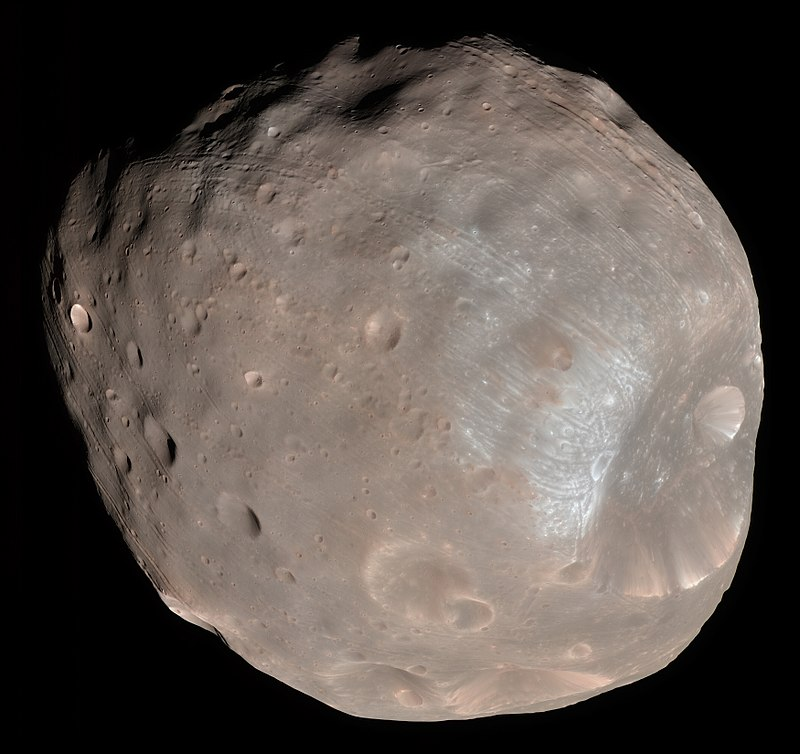=> Zurück zum Artikel
Phobos: einer der zwei Marsmonde: er wurde erst im Jahr 1877 entdeckt, aber - durch Zufall? - bereits um 1726 von Jonathan Swift in seinem Phantasie-Roman Gullivers Reisen vorhergesagt. © JPL-Caltech / University of Arizona ☛
Phobos
Bildinfo und Lizenz
Bildinfo
Phobos: einer der zwei Marsmonde: er wurde erst im Jahr 1877 entdeckt, aber - durch Zufall? - bereits um 1726 von Jonathan Swift in seinem Phantasie-Roman Gullivers Reisen vorhergesagt. Originalbeschriftung: Color image of Phobos, imaged by the Mars Reconnaissance Orbiter on 23 March 2008. The High Resolution Imaging Science Experiment (HiRISE) camera on NASA's Mars Reconnaissance Orbiter took two images of the larger of Mars' two moons, Phobos, within 10 minutes of each other on 23 March 2008. This is the first, taken from a distance of about 6,800 kilometers (about 4,200 miles). It is presented in color by combining data from the camera's blue-green, red, and near-infrared channels. The illuminated part of Phobos seen in the images is about 21 kilometers (13 miles) across. The most prominent feature in the images is the large crater Stickney in the lower right. With a diameter of 9 kilometers (5.6 miles), it is the largest feature on Phobos. The color data accentuate details not apparent in black-and-white images. For example, materials near the rim of Stickney appear bluer than the rest of Phobos. Based on analogy with materials on our own moon, this could mean this surface is fresher, and therefore younger, than other parts of Phobos. A series of troughs and crater chains is obvious on other parts of the moon. Although many appear radial to Stickney in this image, recent studies from the European Space Agency's Mars Express orbiter indicate that they are not related to Stickney. Instead, they may have formed when material ejected from impacts on Mars later collided with Phobos. The lineated textures on the walls of Stickney and other large craters are landslides formed from materials falling into the crater interiors in the weak Phobos gravity (less than one one-thousandth of the gravity on Earth). In the full-resolution version of this image, a pixel encompasses 6.8 meters (22 feet), providing a resolution (smallest visible feature) of about 20 meters (about 65 feet). The image is in the HiRISE catalog as PSP_007769_9010. Source
Created: March 23rd, 2008 Author: JPL-Caltech / University of Arizona License
This image is from the NASA Imaga Library. On the website is the following note: NASA content - images, audio, video, and computer files used in the rendition of 3-dimensional models, such as texture maps and polygon data in any format - generally are not copyrighted. You may use this material for educational or informational purposes, including photo collections, textbooks, public exhibits, computer graphical simulations and Internet Web pages. This general permission extends to personal Web pages. [This note was copied from the image gallery site on March 4th, 2020] Warranty
No guarantee can be given as to the correctness of facts implied or explicitly stated. Usage is completey at your own risk. 💣 Originalseite
Das Bild ist Teil eines online-Lexikons. Rhetos Lernlexikon Mathematik, Aachen:  Phobos: einer der zwei Marsmonde: er wurde erst im Jahr 1877 entdeckt, aber - durch Zufall? - bereits um 1726 von Jonathan Swift in seinem Phantasie-Roman Gullivers Reisen vorhergesagt.
© JPL-Caltech / University of Arizona => Zurück zum Artikel
Phobos: einer der zwei Marsmonde: er wurde erst im Jahr 1877 entdeckt, aber - durch Zufall? - bereits um 1726 von Jonathan Swift in seinem Phantasie-Roman Gullivers Reisen vorhergesagt.
© JPL-Caltech / University of Arizona => Zurück zum Artikel
